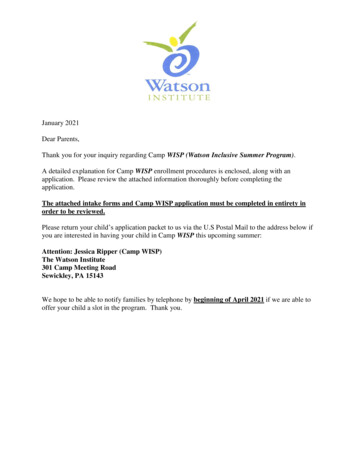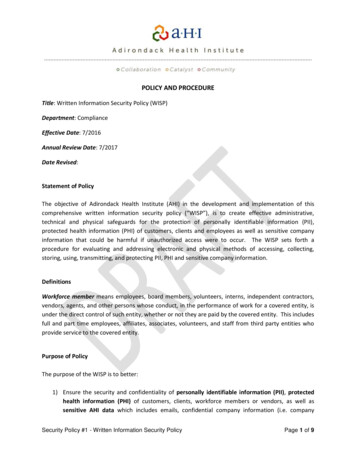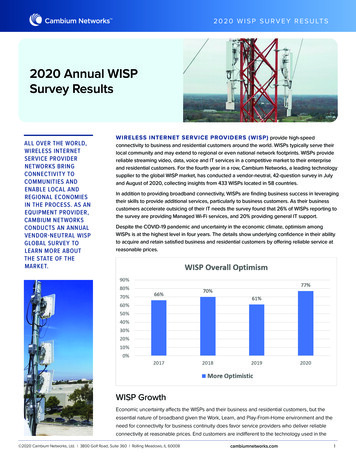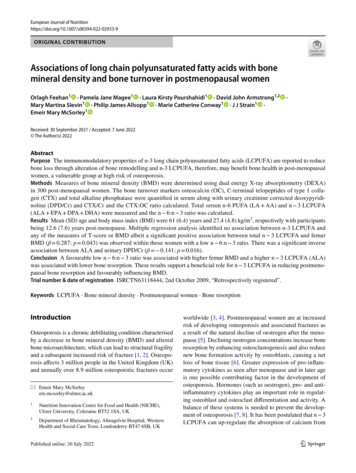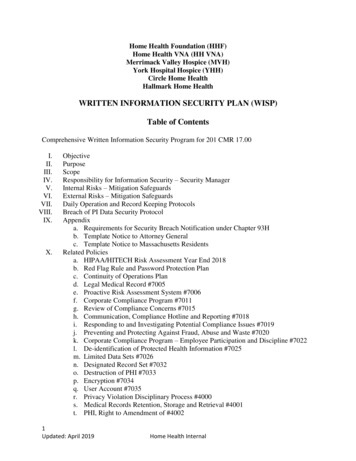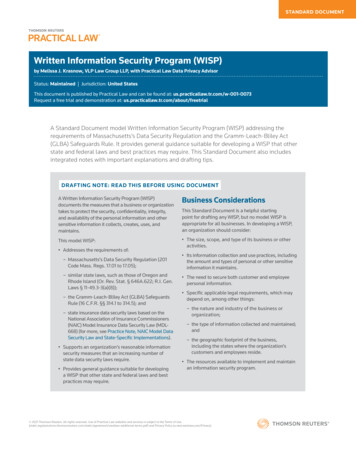
Transcription
STANDARD DOCUMENTWritten Information Security Program (WISP)by Melissa J. Krasnow, VLP Law Group LLP, with Practical Law Data Privacy AdvisorStatus: Maintained Jurisdiction: United StatesThis document is published by Practical Law and can be found at: us.practicallaw.tr.com/w-001-0073Request a free trial and demonstration at: us.practicallaw.tr.com/about/freetrialA Standard Document model Written Information Security Program (WISP) addressing therequirements of Massachusetts’s Data Security Regulation and the Gramm-Leach-Bliley Act(GLBA) Safeguards Rule. It provides general guidance suitable for developing a WISP that otherstate and federal laws and best practices may require. This Standard Document also includesintegrated notes with important explanations and drafting tips.DRAFTING NOTE: READ THIS BEFORE USING DOCUMENTA Written Information Security Program (WISP)documents the measures that a business or organizationtakes to protect the security, confidentiality, integrity,and availability of the personal information and othersensitive information it collects, creates, uses, andmaintains.Business ConsiderationsThis model WISP: The size, scope, and type of its business or otheractivities. Addresses the requirements of:This Standard Document is a helpful startingpoint for drafting any WISP, but no model WISP isappropriate for all businesses. In developing a WISP,an organization should consider:–– Massachusetts’s Data Security Regulation (201Code Mass. Regs. 17.01 to 17.05); Its information collection and use practices, includingthe amount and types of personal or other sensitiveinformation it maintains.–– similar state laws, such as those of Oregon andRhode Island (Or. Rev. Stat. § 646A.622; R.I. Gen.Laws § 11-49.3-3(a)(8)); The need to secure both customer and employeepersonal information.–– the Gramm-Leach-Bliley Act (GLBA) SafeguardsRule (16 C.F.R. §§ 314.1 to 314.5); and–– state insurance data security laws based on theNational Association of Insurance Commissioners(NAIC) Model Insurance Data Security Law (MDL668) (for more, see Practice Note, NAIC Model DataSecurity Law and State-Specific Implementations). Supports an organization’s reasonable informationsecurity measures that an increasing number ofstate data security laws require. Provides general guidance suitable for developinga WISP that other state and federal laws and bestpractices may require. Specific applicable legal requirements, which maydepend on, among other things:–– the nature and industry of the business ororganization;–– the type of information collected and maintained;and–– the geographic footprint of the business,including the states where the organization’scustomers and employees reside. The resources available to implement and maintainan information security program. 2021 Thomson Reuters. All rights reserved. Use of Practical Law websites and services is subject to the Terms of c/agreement/westlaw-additional-terms.pdf) and Privacy Policy (a.next.westlaw.com/Privacy).
Written Information Security Program (WISP)Even when not explicitly required by law, a welldeveloped and maintained WISP may provide benefits,including: Prompting the business to proactively assess riskand implement measures to protect personal andother sensitive information. Educating employees and other stakeholders aboutthe actions they need to take to protect personaland other sensitive information. Helping to communicate data security expectationsand practices to leadership, customers, and otherinterested parties, such as regulators.The GLBA applies to financial institutions thatcollect consumers’ non-public personal information(NPI) (16 C.F.R. § 313.3(n)(1)). The GLBA SafeguardsRule requires companies to develop, implement,and maintain a WISP that includes appropriateadministrative, technical, and physical safeguardsto protect consumer information (16 C.F.R. § 314.3).It also requires them to contractually obligate theirservice providers who handle NPI to implement andmaintain similar safeguards (16 C.F.R. § 314.4(d)).This model WISP is helpful in complying with theinformation security program requirements found in:The Safeguards Rule lays out WISP requirementsmore broadly than the Massachusetts Data SecurityRegulation, making this Standard Document alsosuitable for developing a GLBA-compliant WISP, usingalternative language to define personal information(see Drafting Note, Scope: Personal Information).For more details on GLBA and the Safeguards Rule,see Practice Note, GLBA: The Financial Privacy andSafeguards Rules: The Safeguards Rule. Massachusetts’s Data Security Regulation (201Code Mass. Regs. 17.01 to 17.05) (see MassachusettsData Security Regulation).Health Insurance Portability andAccountability Act The GLBA Safeguards Rule (16 C.F.R. §§ 314.1 to314.5) (see Gramm-Leach-Bliley Act SafeguardsRule).The Health Insurance Portability and AccountabilityAct (HIPAA) applies to certain health care entitiesand their service providers (business associates). TheHIPAA Security Rule requires covered entities andtheir business associates to: Establishing that the organization takes reasonablesteps to protect personal and other sensitiveinformation, especially if a security incident occursthat risks litigation or enforcement action.Legal Considerations Other state laws and best practices with datasecurity requirements (see Drafting Note, BestPractices and Resources and Practice Notes,State Data Security Laws: Overview and NAICModel Data Security Law and State-SpecificImplementations).Massachusetts Data SecurityRegulation Implement and maintain specified administrative,technical, and physical safeguards. Implement reasonable and appropriate writtenpolicies and procedures. Maintain a written record of required activities, suchas risk assessments.The Massachusetts Data Security Regulation (201Code Mass. Regs. 17.01 to 17.05) provides detailedWISP requirements and applies to any businessthat collects Massachusetts residents’ personalinformation, regardless of business location. ThisStandard Document follows the Massachusetts DataSecurity Regulation’s requirements and should beused with Practice Note, Written Information SecurityPrograms: Compliance with the Massachusetts DataSecurity Regulation.2 Practical LawGramm-Leach-Bliley Act SafeguardsRule(45 C.F.R. §§ 164.302 to 164.318 and see, PracticeNote, HIPAA Security Rule: Safeguards and RelatedOrganizational and Document Requirements.)Covered entities and their business associates should: Ensure that their information security policies andprocedures are HIPAA-compliant. Recognize that a WISP may provide them witha convenient way to organize and describe theirinformation security program. 2021 Thomson Reuters. All rights reserved. Use of Practical Law websites and services is subject to the Terms of c/agreement/westlaw-additional-terms.pdf) and Privacy Policy (a.next.westlaw.com/Privacy).
Written Information Security Program (WISP) Develop and maintain a WISP if required by otherapplicable laws, such as the Massachusetts DataSecurity Regulation.Best Practices and ResourcesSeveral state and federal agencies have issued guidancedocuments to assist large and small businesses andother organizations in performing risk assessmentsand developing, implementing, and maintaining theirinformation security programs, including: The Federal Trade Commission’s (FTC):–– Protecting Personal Information: A Guide forBusiness, which provides a five-principle approachto building an information security plan; and Identify all applicable laws and standards that affectthe organization’s use of personal or other sensitiveinformation, including any contractual obligations. Define the WISP’s scope, including the personalinformation, any other sensitive information, andlegal requirements it intends to address.(See Drafting Note, Scope and Practice Note, WrittenInformation Security Programs: Compliance with theMassachusetts Data Security Regulation: PreliminaryConsiderations.)Related Policies and Other Documents–– Start with Security: A Guide for Business, whichoffers ten lessons learned from its data securityenforcement actions, with practical guidance onhow to reduce risks for all businesses.An organization’s WISP outlines the purpose, scope,and core elements of its information security program.However, organizations often define their specificsecurity measures in related documents, including: The National Institute of Standards andTechnology’s (NIST) Framework for ImprovingCritical Infrastructure Cybersecurity, whichorganizes various globally recognized industrystandards and best practices into a model that anyorganization can adapt and use to identify risks andbuild an information security program (see PracticeNote, The NIST Cybersecurity Framework). Risk assessment reports and remediation plans (formore information on planning and performing riskassessments, see Practice Note, Data Security RiskAssessments and Reporting and Performing DataSecurity Risk Assessments Checklist).These resources’ recommendations are comparableto the Massachusetts Data Security Regulation’srequirements and other similar state and federal laws,while providing additional technical guidance in anaccessible form.Drafting and ImplementationConsiderationsAn organization’s WISP should be consistent withits current data collection and information securitypractices unless specific program plan documentationis in place to close any gaps. Businesses createpotential compliance, enforcement, and litigation risksby putting in place and committing to WISPs they donot follow.Before developing a WISP, an organization should: Gather all relevant information regarding thepersonal and other sensitive information that it3 Practical Lawcollects, creates, uses, and maintains, includingcurrent information security practices. One or more workforce-facing information securitypolicy documents, such as those that establishpolicies regarding:–– information classification and handling practices;–– user access management and passwords;–– computer and network security;–– physical security;–– incident reporting and response;–– employee and contractor use of technology, forexample, acceptable use and Bring Your OwnDevice to Work (BYOD) policies; and–– information systems acquisition, development,and maintenance.(For more on developing information securitypolicies and an example policy, see Practice Note,Developing Information Security Policies andStandard Document, Information Security Policy.) Process and procedures documents that detail howto implement and maintain particular safeguards,typically for technical or other support staff to use. 2021 Thomson Reuters. All rights reserved. Use of Practical Law websites and services is subject to the Terms of c/agreement/westlaw-additional-terms.pdf) and Privacy Policy (a.next.westlaw.com/Privacy).
Written Information Security Program (WISP)Awareness and TrainingAssumptionsOrganizations should also consider how to bestdistribute and build awareness of the WISP andrelated policies, processes, and procedures. Forexample, businesses may choose to integrateinformation security training with existing ethics andcompliance programs.This WISP assumes that the organization onlycollects, creates, uses, and maintains US residents’personal information. If the organization handlespersonal information in non-US locations or plansto transfer personal information to the US, it may besubject to data security or privacy laws in those otherjurisdictions. Privacy laws vary significantly, andare often more stringent outside the US, especiallyin the EU (see Data protection: Country Q&A Toolto compare laws in the US and selected non-USlocations).At a minimum, organizations should: Specifically train all employees and contractors,especially those who handle personal or othersensitive information as part of their duties, on theirWISP and relevant policies and procedures (seeStandard Document, Information Security Training:Presentation Materials and Delivering InformationSecurity Policies and Training Checklist). Require all employees and contractors to formallyacknowledge their receipt and understanding of thedocumentation and training, using written forms oran online learning system.Bracketed ItemsCounsel should complete bracketed items in ALLCAPS with the relevant facts. Bracketed items insentence case are either optional provisions or includealternative language choices that counsel may select,add, or delete at their discretion. Retain training and acknowledgment records.Written Information Security Program (WISP)The objectives of this comprehensive written information security program (“WISP”) include defining, documenting, andsupporting the implementation and maintenance of the administrative, technical, and physical safeguards [COMPANY]has selected to protect the personal information it collects, creates, uses, and maintains. This WISP has been developedin accordance with the requirements of the [Massachusetts Data Security Regulation, 201 Code Mass. Regs. 17.01 to17.05, other similar US state laws, and [LIST ADDITIONAL APPLICABLE LAWS AND OBLIGATIONS]/LIST SPECIFICALLYAPPLICABLE LAWS AND OBLIGATIONS].If this WISP conflicts with any legal obligation or other [COMPANY] policy or procedure, the provisions of this WISP shallgovern, unless the Information Security Coordinator specifically reviews, approves, and documents an exception (seeSection 3).DRAFTING NOTE: WISP OBJECTIVES: APPLICABLE LAWS AND OBLIGATIONSIn this section, the organization should identify theapplicable laws, standards, policies, and contractualobligations that may affect its use of personalinformation or impose obligations on its information4 Practical Lawsecurity program (see Drafting Notes, LegalConsiderations and Drafting and ImplementationConsiderations). 2021 Thomson Reuters. All rights reserved. Use of Practical Law websites and services is subject to the Terms of c/agreement/westlaw-additional-terms.pdf) and Privacy Policy (a.next.westlaw.com/Privacy).
Written Information Security Program (WISP)1. Purpose. The purpose of this WISP is to:(a) Ensure the security, confidentiality, integrity, and availability of personal [and other sensitive] information[COMPANY] collects, creates, uses, and maintains.(b) Protect against any anticipated threats or hazards to the security, confidentiality, integrity, or availability of suchinformation.(c) Protect against unauthorized access to or use of [COMPANY]-maintained personal [and other sensitive]information that could result in substantial harm or inconvenience to any customer or employee.(d) Define an information security program that is appropriate to [COMPANY]’s size, scope, and business, its availableresources, and the amount of personal [and other sensitive] information that [COMPANY] owns or maintains on behalfof others, while recognizing the need to protect both customer and employee information.DRAFTING NOTE: PURPOSEThis purpose statement tracks the high-levelWISP requirements stated in the MassachusettsData Security Regulation and other similarstate and federal laws, including the GLBA (seePractice Note, Written Information Security Programs:Compliance with the Massachusetts Data SecurityRegulation: Massachusetts Regulation: General WISPRequirements).2. Scope. This WISP applies to [all employees, contractors, officers, and directors of [COMPANY]/[DEFINE SCOPE]]. Itapplies to any records that contain personal [or other sensitive] information in any format and on any media, whether inelectronic or paper form.(a) For purposes of this WISP, “personal information” means either a US resident’s first and last name or first initialand last name in combination with any one or more of the following data elements, or any of the following dataelements standing alone or in combination, if such data elements could be used to commit identity theft against theindividual:(i) Social Security number;(ii) Driver’s license number, other government-issued identification number, including passport number, or tribalidentification number;(iii) Account number, or credit or debit card number, with or without any required security code, access code,personal identification number, or password that would permit access to the individual’s financial account [GLBA:, or any personally identifiable financial information or consumer list, description, or other grouping derived frompersonally identifiable financial information, where personally identifiable financial information includes anyinformation:(A) A consumer provides [COMPANY] to obtain a financial product or service;(B) About a consumer resulting from any transaction involving a financial product or service with [COMPANY];or(C) Information [COMPANY] otherwise obtains about a consumer in connection with providing a financialproduct or service].(iv) [Health information, including information [regarding the individual’s medical history or mental or physicalcondition, or medical treatment or diagnosis by a health care professional/created or received by [COMPANY]]/5 Practical Law 2021 Thomson Reuters. All rights reserved. Use of Practical Law websites and services is subject to the Terms of c/agreement/westlaw-additional-terms.pdf) and Privacy Policy (a.next.westlaw.com/Privacy).
Written Information Security Program (WISP)[HIPAA: , which identifies or for which there is a reasonable basis to believe the information can be used to identifythe individual and which relates to the past, present, or future physical or mental health or condition of the individual,the provision of health care to the individual, or payment for the provision of health care to the individual]];(v) Health insurance identification number, subscriber identification number, or other unique identifier used by ahealth insurer;(vi) Biometric data collected from the individual and used to authenticate the individual during a transaction,such as an image of a fingerprint, retina, or iris; or(vii) Email address with any required security code, access code, or password that would permit access to anindividual’s personal, medical, insurance, or financial account.(b) Personal information does not include lawfully obtained information that is available to the general public,including publicly available information from federal, state, or local government records.(c) [(d) For purposes of this WISP, “sensitive information” means data that:(i) [COMPANY] considers to be highly confidential information; or(ii) If accessed by or disclosed to unauthorized parties, could cause significant or material harm to [COMPANY], itscustomers, or its business partners.(iii) Sensitive information includes, but is not limited to, personal information. [See [COMPANY]’s informationclassification policy, available at [REFERENCE TO POLICY].](iv) ]DRAFTING NOTE: SCOPEThe organization should determine whether theWISP applies enterprise-wide or only to selectedbusiness units or activities and adjust the scopestatement as needed (see Practice Note, WrittenInformation Security Programs: Compliance with theMassachusetts Data Security Regulation: Scope of theWISP).Generally, the WISP should define personalinformation considering:Personal Information Applicable laws that the organization referencesin its privacy policy or other public statements (seeDrafting Note, Legal Considerations).The definition of personal information providedfollows the generally applicable Massachusetts DataSecurity Regulation and similar state laws, such asthose of Oregon and Rhode Island (Or. Rev. Stat.§ 646A.622; R.I. Gen. Laws § 11-49.3-3(a)(8)). Whilethere are similarities, states often define personalinformation differently. For details on how each statedefines personal information, see Practice Note, StateData Breach Laws Protected Personal InformationChart: Overview.6 Practical Law The data the business collects, creates, uses, ormaintains. The organization’s near-term business plans, suchas the states where its customers or employees mayreside. What the organization otherwise considers personalinformation, including any information that it mustprotect by contract with third parties.If applicable: Section 2(a)(iii) should include the additional textto meet GLBA’s definition of non-public personalinformation (16 C.F.R. § 313.3(n)(1)). 2021 Thomson Reuters. All rights reserved. Use of Practical Law websites and services is subject to the Terms of c/agreement/westlaw-additional-terms.pdf) and Privacy Policy (a.next.westlaw.com/Privacy).
Written Information Security Program (WISP) Section 2(a)(iv) should use the optional text regardingHIPAA to meet HIPAA’s requirements (45 C.F.R.§ 160.103).Sensitive InformationIf the organization intends for the WISP to coverother data that it considers to be sensitive, inaddition to personal information, then counselshould include the optional text in this section andthroughout the WISP. For example, a business maywish to apply the same WISP to highly confidentialinformation regarding its products, business plans,or certain operations (or third-party contracts mayrequire it to do so).Sensitive or highly confidential information: Typically includes data that if accessed by ordisclosed to unauthorized parties could causesignificant or material harm to the organization, itscustomers, or its business partners. Includes, but is not limited to, personal information. Contrasts with an organization’s less sensitive, butstill non-public internal use only or confidentialinformation.If the organization has an information classificationpolicy, for example, as part of its information securitypolicies and procedures (see Section 5), the WISP shouldinclude a reference as shown in the optional text.3. Information Security Coordinator. [COMPANY] has designated [TITLE] to implement, coordinate, and maintain thisWISP (the “Information Security Coordinator”). The Information Security Coordinator shall be responsible for:(a) Initial implementation of this WISP, including:(i) Assessing internal and external risks to personal [and other sensitive] information and maintaining relateddocumentation, including risk assessment reports and remediation plans (see Section 4);(ii) Coordinating the development, distribution, and maintenance of information security policies and procedures(see Section 5);(iii) Coordinating the design of reasonable and appropriate administrative, technical, and physical safeguards toprotect personal [and other sensitive] information (see Section 6);(iv) Ensuring that the safeguards are implemented and maintained to protect personal [and other sensitive]information throughout [COMPANY], where applicable (see Section 6);(v) Overseeing service providers that access or maintain personal [and other sensitive] information on behalf of[COMPANY] (see Section 7);(vi) Monitoring and testing the information security program’s implementation and effectiveness on an ongoingbasis (see Section 8);(vii) Defining and managing incident response procedures (see Section 9); and(viii) Establishing and managing enforcement policies and procedures for this WISP, in collaboration with[COMPANY] human resources and management (see Section 10).(b) Employee, contractor, and (as applicable) stakeholder training, including:(i) Providing periodic training regarding this WISP, [COMPANY]’s safeguards, and relevant information securitypolicies and procedures for all employees, contractors, and (as applicable) stakeholders who have or may haveaccess to personal [or other sensitive] information;(ii) Ensuring that training attendees formally acknowledge their receipt and understanding of the training andrelated documentation, through [written acknowledgement forms/[DESCRIBE ANY ONLINE ACKNOWLEDGMENTPROCESS]]; and(iii) Retaining training and acknowledgment records.7 Practical Law 2021 Thomson Reuters. All rights reserved. Use of Practical Law websites and services is subject to the Terms of c/agreement/westlaw-additional-terms.pdf) and Privacy Policy (a.next.westlaw.com/Privacy).
Written Information Security Program (WISP)(c) Reviewing this WISP and the security measures defined here at least annually, or whenever there is a materialchange in [COMPANY]’s business practices that may reasonably implicate the security, confidentiality, integrity, oravailability of records containing personal [or other sensitive] information (see Section 11).(d) Defining and managing an exceptions process to review, approve or deny, document, monitor, and periodicallyreassess any necessary and appropriate, business-driven requests for deviations from this WISP or [COMPANY]’sinformation security policies and procedures.(e) Periodically reporting to [COMPANY] management regarding the status of the information security program and[COMPANY]’s safeguards to protect personal [and other sensitive] information.DRAFTING NOTE: INFORMATION SECURITY COORDINATORConsiderations for designating an information securitycoordinator depend on the organization’s specificcircumstances and may include:The organization should also consider the appropriatebusiness units to involve in program oversight, whichmay include: The organization’s size, industry, and regulators. Legal. The types of personal and other sensitiveinformation the organization owns or maintains onbehalf of others. Information technology (IT). The employees responsible for the organization’scompliance with security requirements, includingcompliance with its internal policies and procedures,contracts, and relevant laws and industry standards. Leadership support and sponsorship to ensurethe information security coordinator has sufficientauthority to implement and enforce the WISP. Privacy or a broader ethics and compliance unit.The specific title used for the information securitycoordinator role may also vary according to theorganization’s size, industry, and other characteristics.Counsel should draft the WISP to refer to thecoordinator by current title, and not individual name,to minimize maintenance requirements and anypotential confusion if personnel change.4. Risk Assessment. As a part of developing and implementing this WISP, [COMPANY] will conduct a periodic,documented risk assessment[, at least annually, or whenever there is a material change in [COMPANY]’s businesspractices that may implicate the security, confidentiality, integrity, or availability of records containing personal [or othersensitive] information].(a) The risk assessment shall:(i) Identify reasonably foreseeable internal and external risks to the security, confidentiality, integrity, oravailability of any electronic, paper, or other records containing personal [or other sensitive] information;(ii) Assess the likelihood and potential damage that could result from such risks, taking into consideration thesensitivity of the personal [and other sensitive] information; and(iii) Evaluate the sufficiency of relevant policies, procedures, systems, and safeguards in place to control suchrisks, in areas that include, but may not be limited to:(A) Employee, contractor, and (as applicable) stakeholder training and management;(B) Employee, contractor, and (as applicable) stakeholder compliance with this WISP and related policies andprocedures;8 Practical Law 2021 Thomson Reuters. All rights reserved. Use of Practical Law websites and services is subject to the Terms of c/agreement/westlaw-additional-terms.pdf) and Privacy Policy (a.next.westlaw.com/Privacy).
Written Information Security Program (WISP)(C) Information systems, including network, computer, and software acquisition, design, implementation,operations, and maintenance, as well as data processing, storage, transmission, retention, and disposal; and(D) [COMPANY]’s ability to prevent, detect, and respond to attacks, intrusions, and other security incidents orsystem failures.(b) Following each risk assessment, [COMPANY] will:(i) Design, implement, and maintain reasonable and appropriate safeguards to minimize identified risks;(ii) Reasonably and appropriately address any identified gaps; and(iii) Regularly monitor the effectiveness of [COMPANY]’s safeguards, as specified in this WISP (see Section 8).DRAFTING NOTE: RISK ASSESSMENTRisk assessment is a critical element of anyinformation security program. Information securityrisks are best understood using this simple equation:risk threat vulnerability.Threats may include external bad actors or internal(employee or contractor) lapses, whether inadvertentor intentional. Vulnerabilities cover a wide range ofissues related to process, people, and technology,such as: Untrained or inattentive individuals. Improperly secured facilities. Poor implementation, configuration, ormaintenance practices. Flaws in network and computer assets, includinghardware, software, and application issues.See Drafting Note, Best Practices and Resourcesand Practice Notes, Written Information SecurityPrograms: Compliance with the Massachusetts DataSecurity Regulation: Identifying and MinimizingReasonably Foreseeable Internal and External Risksand Data Security Risk Assessments and Reporting forguidance on risk assessments.Risks change over time as: Novel threats emerge. Vulnerabilities are identified and become widelyknown. The business evolves, especially when it:–– makes changes in data collection and handlingpractices;–– introduces new or materially changed productsand services;–– alters its business processes and practices; or–– deploys new, or updates existing, network andcomputer environments.O
A Standard Document model Written Information Security Program (WISP) addressing the requirements of Massachusetts's Data Security Regulation and the Gramm-Leach-Bliley Act . to building an information security plan; and - Start with Security: A Guide for Business, which offers ten lessons learned from its data security enforcement .

